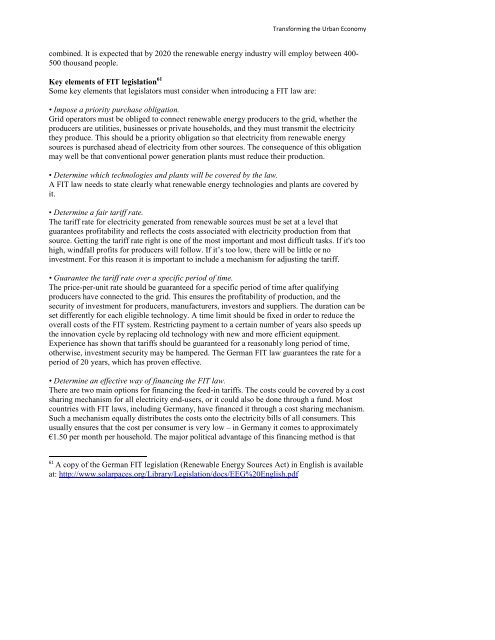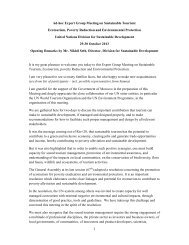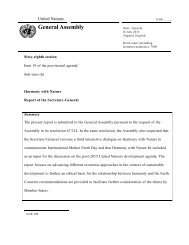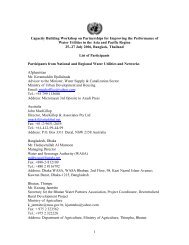A Guide for Sustainable Urban Development of the 21st Century
A Guide for Sustainable Urban Development of the 21st Century
A Guide for Sustainable Urban Development of the 21st Century
Create successful ePaper yourself
Turn your PDF publications into a flip-book with our unique Google optimized e-Paper software.
Trans<strong>for</strong>ming <strong>the</strong> <strong>Urban</strong> Economycombined. It is expected that by 2020 <strong>the</strong> renewable energy industry will employ between 400-500 thousand people.Key elements <strong>of</strong> FIT legislation 61Some key elements that legislators must consider when introducing a FIT law are:• Impose a priority purchase obligation.Grid operators must be obliged to connect renewable energy producers to <strong>the</strong> grid, whe<strong>the</strong>r <strong>the</strong>producers are utilities, businesses or private households, and <strong>the</strong>y must transmit <strong>the</strong> electricity<strong>the</strong>y produce. This should be a priority obligation so that electricity from renewable energysources is purchased ahead <strong>of</strong> electricity from o<strong>the</strong>r sources. The consequence <strong>of</strong> this obligationmay well be that conventional power generation plants must reduce <strong>the</strong>ir production.• Determine which technologies and plants will be covered by <strong>the</strong> law.A FIT law needs to state clearly what renewable energy technologies and plants are covered byit.• Determine a fair tariff rate.The tariff rate <strong>for</strong> electricity generated from renewable sources must be set at a level thatguarantees pr<strong>of</strong>itability and reflects <strong>the</strong> costs associated with electricity production from thatsource. Getting <strong>the</strong> tariff rate right is one <strong>of</strong> <strong>the</strong> most important and most difficult tasks. If it's toohigh, windfall pr<strong>of</strong>its <strong>for</strong> producers will follow. If it’s too low, <strong>the</strong>re will be little or noinvestment. For this reason it is important to include a mechanism <strong>for</strong> adjusting <strong>the</strong> tariff.• Guarantee <strong>the</strong> tariff rate over a specific period <strong>of</strong> time.The price-per-unit rate should be guaranteed <strong>for</strong> a specific period <strong>of</strong> time after qualifyingproducers have connected to <strong>the</strong> grid. This ensures <strong>the</strong> pr<strong>of</strong>itability <strong>of</strong> production, and <strong>the</strong>security <strong>of</strong> investment <strong>for</strong> producers, manufacturers, investors and suppliers. The duration can beset differently <strong>for</strong> each eligible technology. A time limit should be fixed in order to reduce <strong>the</strong>overall costs <strong>of</strong> <strong>the</strong> FIT system. Restricting payment to a certain number <strong>of</strong> years also speeds up<strong>the</strong> innovation cycle by replacing old technology with new and more efficient equipment.Experience has shown that tariffs should be guaranteed <strong>for</strong> a reasonably long period <strong>of</strong> time,o<strong>the</strong>rwise, investment security may be hampered. The German FIT law guarantees <strong>the</strong> rate <strong>for</strong> aperiod <strong>of</strong> 20 years, which has proven effective.• Determine an effective way <strong>of</strong> financing <strong>the</strong> FIT law.There are two main options <strong>for</strong> financing <strong>the</strong> feed-in tariffs. The costs could be covered by a costsharing mechanism <strong>for</strong> all electricity end-users, or it could also be done through a fund. Mostcountries with FIT laws, including Germany, have financed it through a cost sharing mechanism.Such a mechanism equally distributes <strong>the</strong> costs onto <strong>the</strong> electricity bills <strong>of</strong> all consumers. Thisusually ensures that <strong>the</strong> cost per consumer is very low – in Germany it comes to approximately€1.50 per month per household. The major political advantage <strong>of</strong> this financing method is that61A copy <strong>of</strong> <strong>the</strong> German FIT legislation (Renewable Energy Sources Act) in English is availableat: http://www.solarpaces.org/Library/Legislation/docs/EEG%20English.pdf
















